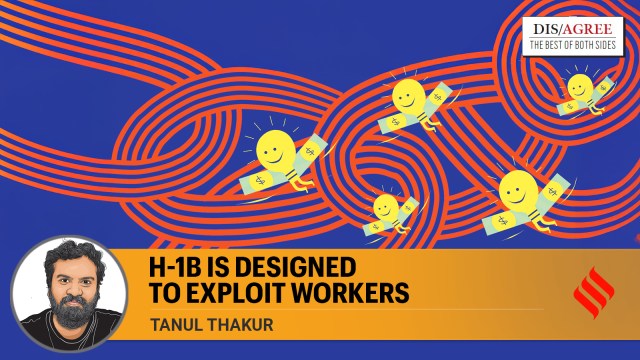
I was once an H-1B worker — neither the “best” nor the “brightest”. I had failed the entrance exam for the Indian Institute of Technology. I had failed to make it to the second rung of prestigious colleges. I had failed. Like many young Indians, I wasn’t passionate about engineering. Yet, pressured by the herd, I revered technical concepts like my dharma. The thought of choice and freedom — sorry, what choice, what freedom? I had none, and it didn’t bother me. So when I secured an H-1B visa, reserved for the “best and the brightest” techies, I felt proud. I had finally been chosen.
The US has thousands of IT body shops — owned by Indians, luring Indians — that force their employees to fake resumes, arrange “proxy” interviews, photoshop immigration documents, pay visa fees, sign coercive contracts, and much more. Besides relinquishing their identities, such H-1Bs languish in squalid “guesthouses”, battle harrowing debts, face deportation threats, and earn nothing when they don’t have clients. In fact, they pay their employers’ taxes to meet the rules of the H-1B programme. The 18th century has returned: Indians have been enslaved by a company — this time by fellow Indians in a foreign land.
Vishal struggled and survived and flourished; my American colleagues lost their jobs in a series of lay-offs. Corporate America’s cruelty made me restless. Even though my employer treated me well, unlike Vishal’s, the H-1B programme had shackled me, too. If I got fired, I’d only get a few weeks to find work to maintain my immigration status. When my firm applied for a green card, it deterred me from taking a new job, as it would reset the decades-long waiting period. I wasn’t myself in the US — I wasn’t allowed to be. My quest for dignity had made me a pawn.
So, after dreading and planning for a year, I quit my job, flew to Mumbai, and darted like a madman — a free man — to my latent romance: Film writing. Three dreamy years later, in 2016, I began working on a nonfiction book. The idea had come to me in a blink: The abuse of the H-1B programme.
I realised that corporate America has concealed the real H-1B scam with great ingenuity, diverting our attention to a “scam within a scam”. Professor Norman Matloff, who has researched the guest worker programme for over three decades and testified before Congress, calls it the “Intels Good, Infosyses Bad” myth — or “racial scapegoating”. The visa abuse also implicates American firms. Their record of suppressing wages — and favouring H-1Bs over Americans — is well documented in news articles, research papers, and court cases. What’s worse? It’s legal.
So Elon Musk is flat-out wrong when he says the H-1B programme is “broken”. It is functioning as intended: Permitting corporations to underpay foreign workers, snub American professionals, and mint money. The H-1B Visa Reform Act of 2004, for instance, restructured the salary slabs — inserting two wage levels, at the 34th and 50th percentiles of the total salaries surveyed for an occupation in an area, below the highest (the 67th percentile) — embedding underpayment in the law itself. The Department of Labor even allows firms to set the prevailing wage levels. Laced with loopholes, they enable companies to steal wages while complying with the law.
The Musk-MAGA clash has revealed two contentious issues: That the US suffers from a “STEM crisis” and that racial bias drives all H-1B critics. Both notions are false. The endemic problem of fake resumes itself — which I found during my reporting and research — negates many H-1Bs’ “best and the brightest” tags. The pro-visa camp also cites a low unemployment figure to render American techies irrelevant. But a paper by the Bureau of Labor Statistics researcher Carolyn Veneri posited that the computer science field, ejecting countless programmers, made the unemployment rate meaningless. So a “former engineer, now a sales clerk at Radio Shack,” summarised Matloff, counted as an “employed sales person, not an unemployed engineer”.
In the late 1980s, the National Science Foundation produced a flawed study on an imminent “STEM crisis” that sparked a Congressional probe and influenced the Excellence in Mathematics, Science, and Engineering Education Act of 1990.
Why did the Act matter? It created the H-1B programme.
The writer’s forthcoming book, Wild Wild East, is about the systemic abuse of the H-1B programme